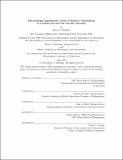Determining appropriate levels of robotic automation in commercial aircraft nacelle assembly
Author(s)
Durham, Bryce J. (Bryce James)
DownloadFull printable version (380.7Kb)
Other Contributors
Leaders for Global Operations Program.
Advisor
Charles H. Fine and Julie A. Shah.
Terms of use
Metadata
Show full item recordAbstract
This thesis examines the application of reconfigurable industrial robotics in the assembly of the engine nacelle inlet for a commercial aircraft. In addition to addressing the achievable level of automation, this thesis also reviews the evaluation of robotics vendor proposals and the accompanying financial justification requisite for implementation. The aircraft industry has long been dominated by manual fabrication and assembly methods. Variability in human skill, however, results in defects, rework, and reduced production throughput. One approach to reduce variability, decrease cycle time, and increase throughput is the implementation of robotic automation for various assembly tasks. Low aircraft production volumes have made it difficult to justify large investments in robotic automation. Decreasing cost and increasing capability of industrial robotics, however, are making investment more palatable. The excellent repeatability of robotic automation can significantly reduce individual task times for a wide range of operations. Standard automated task times are 60{85% lower than standard manual task times for drill and fasten operations which represent the greatest opportunity for cycle time improvements because typical aircraft assembly requires tens of thousands of holes and fasteners. The optimal level of automation is a balance among decreasing manual touch time, improving production capacity, and increasing automation costs. A semi-automated solution is shown to reduce manual touch time by 70% and total touch time by 30%. The implementation of this solution requires an investment of tens of millions of dollars and results in present value savings of hundreds of millions of dollars for the program lifetime.
Description
Thesis: M.B.A., Massachusetts Institute of Technology, Sloan School of Management, 2014. In conjunction with the Leaders for Global Operations Program at MIT. Thesis: S.M., Massachusetts Institute of Technology, Department of Aeronautics and Astronautics, 2014. In conjunction with the Leaders for Global Operations Program at MIT. This electronic version was submitted by the student author. The certified thesis is available in the Institute Archives and Special Collections. 36 Cataloged from student-submitted PDF version of thesis. Includes bibliographical references (pages 71-73).
Date issued
2014Department
Leaders for Global Operations Program at MIT; Massachusetts Institute of Technology. Department of Aeronautics and Astronautics; Sloan School of ManagementPublisher
Massachusetts Institute of Technology
Keywords
Sloan School of Management., Aeronautics and Astronautics., Leaders for Global Operations Program.